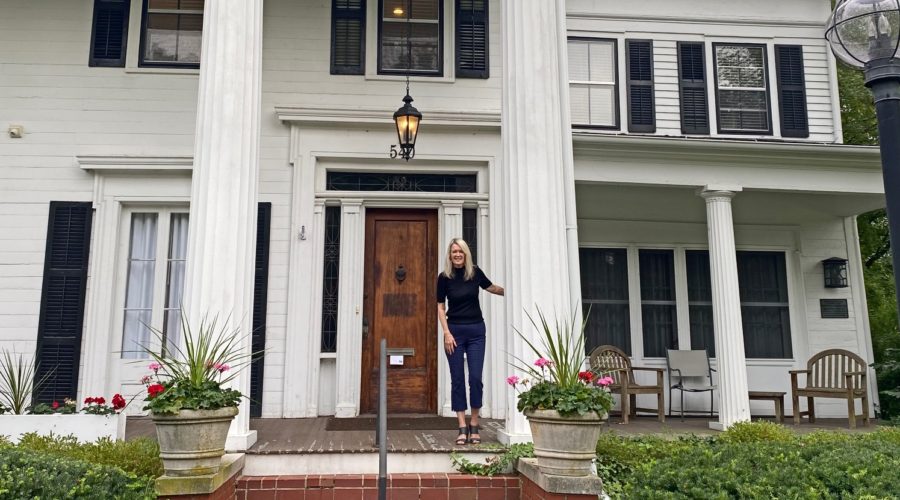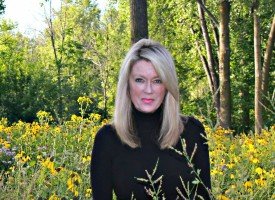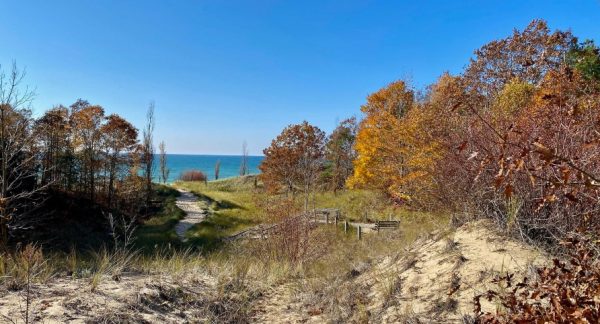Remembering Early Recovery in an Empty House

The author on the front porch Sanford House at Cherry Street for Women
I had what will probably be a once in a lifetime experience this summer. Sanford House at Cherry Street for Women in Grand Rapids, Michigan was closed for a short time for restoration. This is something that happens rarely in the 24/7 world of residential addiction treatment. The 170-year-old floors were restored, and everything was cleaned, steamed, and ship-shape. And consequently, as Marketing Director prepping for a video of the house, I was alone (making beds with military corners and fluffing pillows).
Remembering Early Recovery
It was business as usual as I walked through the treatment center at Cherry Street. I wasn’t expecting a profound experience. In fact, I was wishing I hadn’t volunteered to make beds. But when I got to the final bedroom (and hoisted the 10th mattress), I stopped and looked out of the window.
A few years ago, I toured Loch Leven Castle, where Mary Queen of Scots was imprisoned in 1567. I remember touching the worn rock of a windowsill and thinking, she touched this spot. We are sharing the exact same space. I wondered if she were afraid or defiant. That is the closest feeling I can liken to my Cherry Street experience. Of course, no one is here against their will, and the outcomes are vastly different. But as I looked out on the lawn from the orange bedroom, I felt the same haunting empathy.
Here’s the thing about long-term recovery. One begins to forget what it felt like when sobriety was new. In my case, it is hard to believe I was ever that sick or out of control. Hard to believe I was that vulnerable. The punch in the gut demand from my own brain to DRINK came out of nowhere at the most unexpected times, like hearing a reggae song from a car window. Or finding that bottle of iced vodka in the freezer of a remote Georgia cabin. Or stuck in a rainy traffic jam, inching past a dive bar with a flashing neon sign that said, OPEN COME IN.
I have not had a craving for alcohol in a long time. It is what’s called a ‘paradigm shift’ (a profound change in a fundamental model or perception of events). There was a time when the prevailing framework of my life was alcohol. Now, not so much.

A room with a view… The orange bedroom, Sanford House at Cherry Street for Women.
Empathy for those who are new to recovery…
From the orange bedroom. you can see the front lawn and the fence of arborvitae that defines Sanford House at Cherry Street. Cars and dog-walkers pass by. A historic apartment building across the street has windows into busy lives and cluttered balconies. In other words, the outside world beckons. But if you are looking out of this window as a client, you are probably unable to function in that world. It must seem like looking at a music box village or a snow globe to the women who arrive here.
And I felt with them – the melancholy, fear, defiance, and hopefulness. A mixed emotion the dictionary folks forgot to name. But when you’re new to recovery, no matter how miserable, you are not convinced you can live without your drug of use. In my case, I was not sure I wanted to live without it. It is the loneliest feeling on earth. And yet, you are standing in a beautiful room in a beautiful house, cautiously optimistic. There is a talented group of people waiting to help you. And that bustling, inescapable, real-life outside is just steps away.
Remembering what worked for me in early recovery and beyond…
One thing I have learned after working for Sanford Behavioral Health for 5 1/2 years and talking to thousands of people in recovery and hundreds of therapists, is that everyone has a different path to addiction. A different story. And likewise, every individual has a unique recovery journey. That may seem simplistic, but it is important to remember. Because even the SAMSHA definition of recovery is subjective. My recovery will surely look different than your recovery, except that we are all better behaved, more self-directed, and generally healthier.
This is what worked/works for me (in no particular order):
The Medical Model
My celebrity crush, and the Surgeon General of the United States, Dr. Vivek Murthy says, “Research has shown that substance use disorders are similar in course, management, and outcome to other chronic illnesses, such as hypertension, diabetes, and asthma.” Knowing this, and working for a behavioral health organization helped me understand the sometimes obscure milestones in recovery and rid myself of the inevitable regret, shame, guilt, etc.
Motivation
Motivation is what causes you to put down the drink/drugs. For me, it was an infamous holiday season when I disappointed, hurt, embarrassed and repulsed everyone I care about. For others it might be a medical diagnosis, divorce papers, or a jail sentence. Still others may go skeptically into an intervention. Not everyone finds motivation themselves, but in the end you have to fully participate in your own recovery.
Discipline or this is a life-long commitment
Life-long? As in forever? Once I got the words “forever” and “never” through my thick skull, recovery was easier. I can never have a drink of alcohol, period. Okay, I better have some coping skills. And I’d better find something outside of myself I am passionate about to occupy my abundant free time. Passion comes in all sizes: knitting a scarf; painting a landscape; volunteering at a soup kitchen; adopting a tree sloth at the local zoo; or joining a church, gym or book club. Just get out there and do something.
Professional Help
I am from the bite-a stick school of alcohol secession. I just quit one day and toughed it out. Had I known then what I know now, I would have found a therapist or gone to a treatment center. I did go shakily to an AA meeting, but my intuitive approach would have been strengthened with professional help. Post-acute withdrawal, co-occurring disorders, the onset of a long dormant eating disorder, emotional triggers, hungry-angry-lonely-tired (HALT), WHAT?
Loving, Laughing, Living
I love the Geico commercials where the guy is training folks not to become their parents. In one commercial, a woman holds up a sign that says LIVE, LAUGH, LOVE. The instructor says, “Do we really need a sign to tell us to live, laugh and love?” He tosses the poster in the trash. But aphorisms are useful to those in recovery. Learning to join the living, rebuilding relationships, forming new friendships, and laughing out loud are all markers of mental health that fall by the wayside in active addiction.
Sleep, Social Interaction, Exercise
The Mental State of the World Report, conducted by Sapien Labs 2020, found that sleep deprivation, loneliness and a sedentary lifestyle profoundly diminish every aspect of mental function. I feel a bit like Spock when I say I am working on my ‘social interactions’ but recovery has certainly made all my relationships stronger. In fact, I talk to strangers (just not on airplanes please). And I prioritize sleep, rigorous exercise, and fight the yen to isolate almost every day.
Nature, Hiking, Spirituality
On a recent hike, I was resting on a bench eating grapes when a couple walked by. They sported binoculars and stopped in front of my bench to look into the trees. I heard the thunk, thunk, thunk of a woodpecker and they exclaimed in unison, seeing what I was hearing. Now I want binoculars. I’m almost embarrassed to admit this, but I’m kind of a birder. A nature nerd. The Michigan State Parks and Nature Centers were my savior during the pandemic. Why? Because the sun still rises, birds still nest. And no matter how ghastly I am feeling on a rainy Sunday afternoon, a walk on the beach or through the woods makes me remember and take to heart the inimitable words of Dr. Ian Malcolm, “Life finds a way.”
Message in a bottle to those who walk through these doors…
It takes some getting used to, this full throttle life: accountability, honesty, gratitude. And it takes time to achieve homeostasis. But looking at early recovery from eight years gone, I can tell you that every important aspect of my life is better. Perhaps this is a love letter to those who walk through the doors of Cherry Street. Or better yet, a message in an empty bottle. I was here. I touched this windowsill. And I am with you, feel with you as you embark on this worthy journey.



